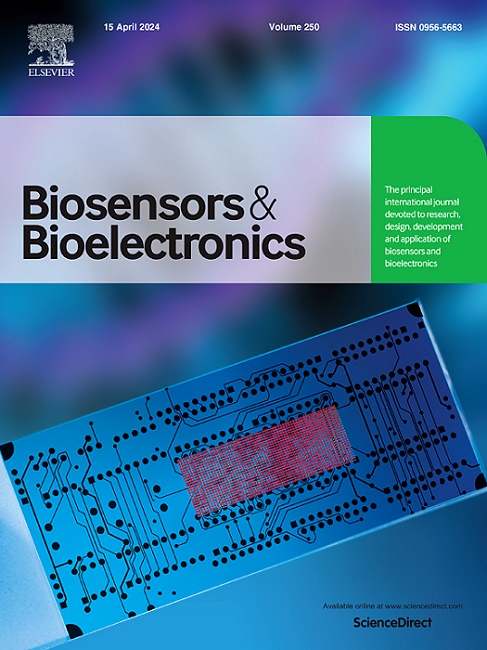用于对虫脒检测的氧空位驱动自供电光电化学传感器
IF 10.5
1区 生物学
Q1 BIOPHYSICS
引用次数: 0
摘要
农产品中残留的对乙酰氨脒可能随饮食进入人体,对人体造成潜在危害。因此,有必要建立一种快速、灵敏的检测ACT的方法。本文以W18O49/CdS为光阳极,BiOCl为光电阴极,Au@PANI为信号放大标记,构建了自供电ACT光电电化学(PEC)传感器。W18O49/CdS的匹配带隙结构可以有效地加速电荷转移,为阴极处强大而稳定的光电流响应奠定基础。特别是,氧空位的引入可以在光敏材料表面诱导缺陷,促进光生载流子的分离。当引入目标分析物ACT时,通过ACT与c - DNA竞争特定结合位点并诱导p - DNA - Au@PANI脱落来实现信号扩增。在上述多种策略的协同作用下,所设计的传感器在100 fM ~ 1 μM范围内具有良好的线性,检测限为65.8 fM (S/N = 3)。此外,该传感器具有优良的选择性、稳定性、重现性,在实际样品中也表现出良好的分析性能。为ACT的检测提供了可靠的方法。本文章由计算机程序翻译,如有差异,请以英文原文为准。

Oxygen vacancies-driven self-powered photoelectrochemical sensor for acetamiprid detection
Residues of acetamiprid (ACT) in agricultural products may enter the human body with the diet and subsequently cause potential harm to humans. Therefore, it is necessary to establish a rapid and sensitive method to detect ACT. In this work, a self−powered ACT photoelectrochemical (PEC) sensor using W18O49/CdS as photoanode, BiOCl as photocathode, and Au@PANI as the signal amplification marker was constructed. The matched band gap structure of the W18O49/CdS can effectively accelerate the charge transfer, laying the foundation for a strong and stable photocurrent response at the cathode. In particular, the introduction of oxygen vacancies can induce defects on the surface of the photosensitive material, facilitating the separation of photogenerated carriers. When the target analyte ACT was introduced, the signal amplification was achieved by using ACT to compete with c−DNA for specific binding sites and inducing p−DNA−Au@PANI shedding. With the synergistic effect of the above multiple strategies, the designed sensor exhibits good linearity in the range of 100 fM ∼1 μM with a detection limit of 65.8 fM (S/N = 3). In addition, the sensor has excellent selectivity, stability, reproducibility, and also shows good analytical performance in real sample. It provides a reliable method for detection of ACT.
求助全文
通过发布文献求助,成功后即可免费获取论文全文。
去求助
来源期刊

Biosensors and Bioelectronics
工程技术-电化学
CiteScore
20.80
自引率
7.10%
发文量
1006
审稿时长
29 days
期刊介绍:
Biosensors & Bioelectronics, along with its open access companion journal Biosensors & Bioelectronics: X, is the leading international publication in the field of biosensors and bioelectronics. It covers research, design, development, and application of biosensors, which are analytical devices incorporating biological materials with physicochemical transducers. These devices, including sensors, DNA chips, electronic noses, and lab-on-a-chip, produce digital signals proportional to specific analytes. Examples include immunosensors and enzyme-based biosensors, applied in various fields such as medicine, environmental monitoring, and food industry. The journal also focuses on molecular and supramolecular structures for enhancing device performance.
 求助内容:
求助内容: 应助结果提醒方式:
应助结果提醒方式:


